Bowling is Life - It's More Than a Game
This blog will be about implementing a bowling unit that will work in ANY setting - and yes, I mean any setting.
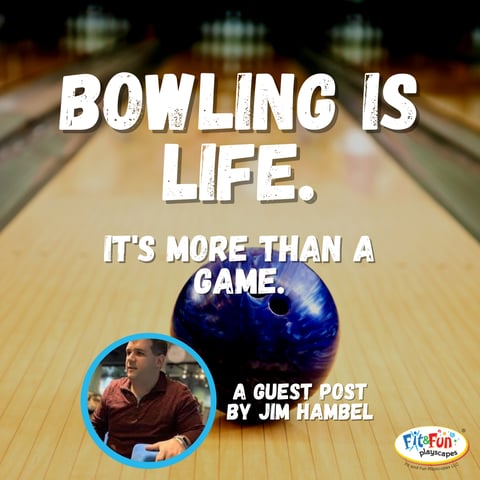
The title of this blog is something my father used to say. Even though he passed away in 2012, I can still vividly remember his voice saying those words:
"Bowling is life - it's more than a game."
He loved bowling, and he passed that love of bowling on to me. On Saturday afternoons in the 1990’s, bowling would be on ABC. It was monumental to my father and I, like Monday Night Football. My parents divorced when I was 10 and I thought bowling would be a way for us to stay close. We bowled in parent-child leagues. He was my coach in high school. All I ever wanted to do was to bowl in a weeknight league with him. Unfortunately, we never got the chance. This is how I got into bowling. I happened to be fairly decent so that’s why I stayed.
So, bowling is something that has been a “JIM-portant” part of my life. I’ve bowled a perfect game four times in competition and you may have seen from some of my bowling resources that I am in the National Bowling Hall of Fame.
Not everyone will go pro, but bowling has opportunities for everyone. For me, I happened to find success with bowling. It was only because I wanted to bowl with my father that I kept with it.
I mention all of this because when you introduce any new game or activity to your students, you never know who will get to love it. It’s been such a beneficial part of my life. It’s helped me develop tenacity, problem-solving, how to be a teammate, how to win, lose, and how to be humble.
BOWLING IN SCHOOL
Bowling naturally scaffolds experiences. There are casual bowling leagues and bowling leagues for those who are more competitive. Bowling is a valuable way to earn scholarship money for high schoolers as well. Plus, bowling adheres to the national and New York State PE standards.
While bowling may be hard to replicate and provide an authentic experience in a gym or hallway, if you can discuss what makes bowling bowling with students, you can, and will, be pleasantly surprised how you can bring the lanes to your school. For example, focus on the experience of bowling: taking turns, working with classmates and trying to obtain the highest score possible. Having students bowl, take turns, and keep score has been tremendous. I see students in all grades helping others with their mechanics because they feel confident to do so. I see students struggle to knock down pins, then make an adjustment and their smiles light up the gym. Bowling may not appear to be a very taxing or vigorous sport, so you might want to try other activities to liven it up. Don’t judge a book by its cover or until you’ve walked a mile in my (bowling) shoes.
There’s one skill to focus on predominantly - underhand rolling and sliding. I like to compare this skill to underhand toss so students can see how these skills differ and compare. With the toss, the object travels in the air and lands. With the roll and slide, the object lands and then travels.
Remember: education without application is entertainment.
JIM HAMBEL'S "BOWL-A-RAMA" BOWLING UNIT
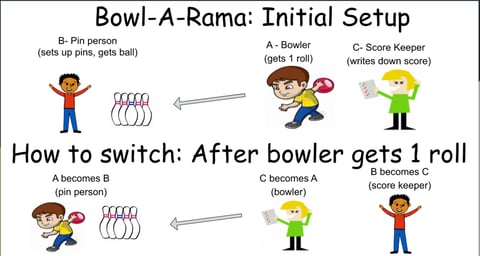 I have included a Wakelet of GIFs, score cards, station signs and other exercises you can use. I see classes once or twice a week.
I have included a Wakelet of GIFs, score cards, station signs and other exercises you can use. I see classes once or twice a week.
In grades K-2, we focus on using the right amount of power and force, and how this impacts our muscles and overall health. Using the right amount of force is important so students know to be successful you have to vary how much you use. You want to challenge yourself. If you do the same thing the same way over and over your muscles will get bored. Using the right amount will allow you to understand how to use the skill to meet any challenge.
For grades 3-5, we focus on building muscular fitness. I often see bowling activities focusing on cardiovascular endurance. That is important for overall well-being. However, muscular fitness is the key to bowling. A bowling ball can range from six to 16 pounds. How many times are you able to roll the ball using the correct cues? How do you know you are getting fit? We discuss this so students can be aware. What is playing without thinking?
By connecting each lesson to this Health Related Fitness component, you can include activities that focus on rolling as well as exercises to help build up muscle strength.
LESSON ONE
For the first lesson, one student bowls one turn while the other person is the pin person. The first lesson focuses on introducing bowling, what it is, assess if students have done it before, and how to make connections to it. They learn what the skill of bowling is.
If you look at the station signs below, I sometimes like using bocce balls and rolling to knock one or three pins.
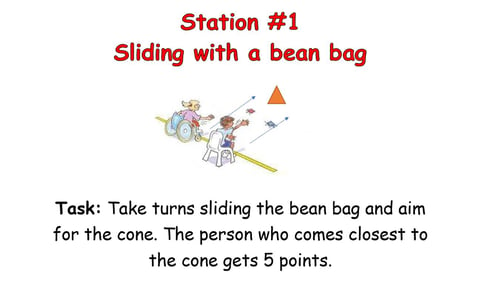
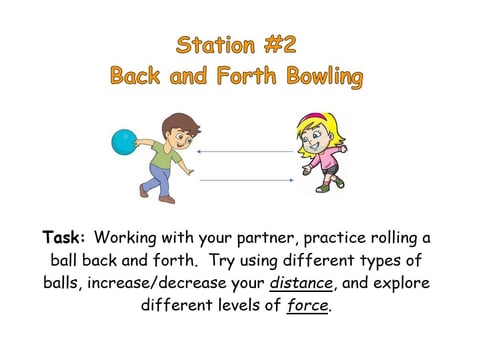
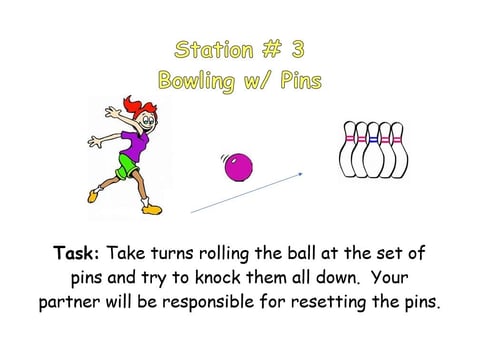
Bowling really works well with small groups. It just works because it’s something that all students can do. It’s a fun social activity. This helps set the stages for other units using small groups. Students can focus on the task AND be successful while utilizing the academic concepts of force or muscular fitness. The games aren’t that complex and the students just enjoy doing them.
For bocce, I use a cone as a target and students are sliding bean bags. Anything that slides works well for this. For K-2, I have them start out using playground balls or the larger gatorskin balls. It is OK to have a student use two hands because they should be focusing on stepping with the opposite foot. For students in 3-5, I have the rhino faux balls that have the three holes in them. I have ones that are light and ones that are heavier. I don’t use the heavier bowling balls until students demonstrate being able to stay in their play space. I only have six of the Bowler’s Ed mats. This works well for single classes and smaller ones. Often, students use a poly spot as their foul line and starting spot. I put the pins against the wall so that makes it easier to reset.
For the final station, it’s my famous exercise dice game. One person rolls the dye. Each number correlates to an exercise. The whole group does the exercise and each person has a choice on the number of reps (5 to 20). Then someone new rolls.
LESSON TWO
The second lesson focuses more on refining the skill.
With K-2, we discuss why you choose different types of power to roll the ball and why.
For grades 3-5, we discuss what worked well last time and why paying attention to muscular fitness is important.
Students add more pins and move their starting poly spot further away from the pins. Some students can take more than one step. You can also have students use the rhino skin bowling balls. The dominant hand holds the ball, and the opposite hand supports it. There are some professional bowlers who are very successful using 2 hands. Refer to the linked Wakelet materials for more details.
I have seen games like bowling bingo. The goal of bowling is to knock down the most amount of pins every time. You want to replicate the cues as often as possible. It may sound like an easy task, but bowling is a game I feel you can get really good at but never truly master.
As a bowler, I want to get into a rhythm where all I have to do is focus on rolling the ball consistently. This is easier said than done. So many times I thought I did all the steps right and got only nine pins. Focusing on the cues and trying to repeat them to obtain the same result over and over is a challenge in itself. For instance, aiming for three pins after knocking down 10 pins is counterproductive. I want to be able to build on the success I had. If I roll a strike, I want to be able to repeat the process. You wouldn’t have a student practice a basketball jump shot and then bounce it off your foot.
Our goal should be that they practice it in the gym and then, when they go to a court or bowling alley, they can use what they learned.
LESSON THREE
The third lesson usually introduces score cards. I say usually because this depends on how the previous two lessons went. If students are struggling on working together, or not getting the concept of rotation, go back and review it. Scaffold it. Once the students get the gist of how the game goes, it often runs itself.
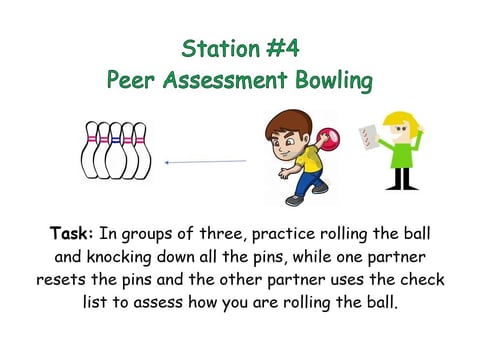
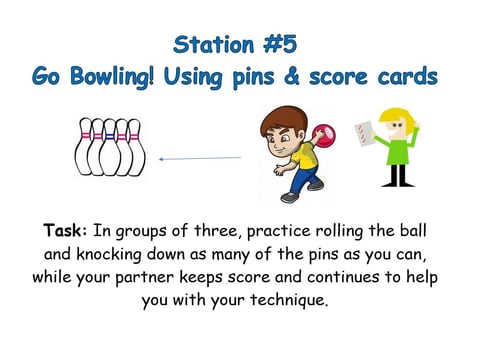
Have students move their start spots back or up. Have them experiment with types of force. If students are inconsistent, remind them to follow through when they release the ball.
As the lesson goes on, we discuss why we use numbers in PE and what they mean. Have students make this connection. Students in grades 3-5 learn to look for patterns in math. Looking out for patterns and why they develop is something students really respond to.
Strategy and teamwork come into play as well. In bowling, the lane does not always show the best path to roll the ball for success. For example, if Mr. Hambel bowls a strike, but then moves back to challenge himself and only gets two pins, is that a successful strategy?
LESSON FOUR
The fourth lesson builds on score cards, uses 10 pins, and gives an authentic experience. Students are working in small groups every time. Don’t be surprised if students are playing on their own for 80% of the lesson.
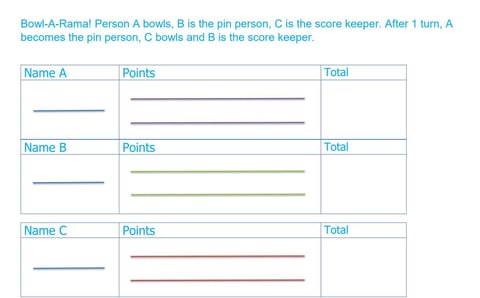
Since bowling focuses on score and data, this is a good way to introduce to your students how to analyze numbers and their usage in exercise even more.
Do scores accurately reflect how well you did? Using the GIF as a rubric, students really get to know how to do the skill of rolling and assess themselves. You’re focusing on the same concepts every time, but building on them and allowing students to challenge themselves.
I use these same constructs for other units as well. It sets the stage for predictable routines. Students really appreciate the GIFs and the scorecards work with just about any small sided activity.
CONCLUSION
I want to say thank you to Fit and Fun Playscapes for the opportunity to further discuss the nuances of my bowling unit. I firmly believe this approach will work in a gym, a hallway, or even an auditorium.
Please feel free to use these resources as you need, just make a copy of them first.
Our job in building a quality PE program is implementing different activities that students might not otherwise get to try. While bowling may not be for everyone, it is considered a lifelong sport for good reason. Some people may stick with it their whole lives. Some may just choose to use their knowledge when they go bowling socially.
You never know though - there might be a student or two in your class for whom bowling becomes more than just a game.
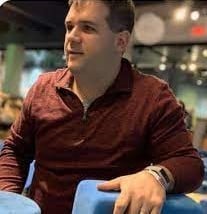
James (Jim) Hambel is an elementary school physical education teacher in New York City. He has a teaching license in PE as well as general education and special education, grades 1-6.
Jim is a member of the professional bowlers association. He is also a member of the US Bowling Hall of Fame.
Recently, he received the award for the 2020 NYS AHPERD Elementary PE Section Amazing Person and 2021 Dr. R. Doris Corbett Johnson Leaders for Our Future Award. He has a beautiful wife and two amazing daughters.


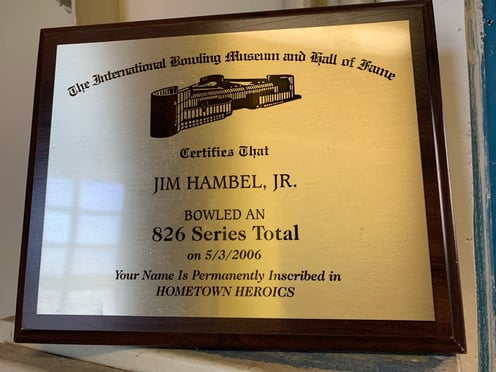

Leave a comment